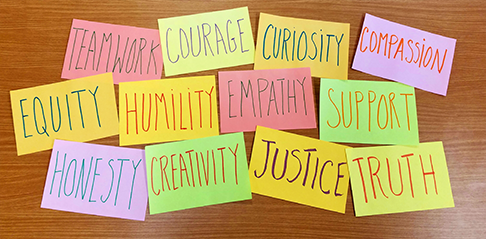
To the Teacher:
The election has brought up strong feelings for many students, and, created tension in some schools. This activity aims to help students create a classroom and school community that is safe, welcoming and supportive, despite some turmoil in the outside world.
In this activity, students will discuss the values that are important to them in their classroom and in school; think of ways they can stand up for values they believe in; and create a poster, bulletin board, or wall of art/writing to remind them of the community they are building together. This activity can be used as a follow-up to our recent lesson, Election Emotions: Sharing & Community-Building. As an alternative to this lesson, see Building Post Election Community: The Power of Kindness.
Materials:
- Chart paper or board
- Index cards or post-its
- Paper - possibly cut into halves or quarters depending on how much wall space you have
- Markers, crayons, or pencils
- Tape
- Any other decorative materials you may want to add
Sharing Values and Stories
Explain that today the class will work together to create something to remind everyone of the values that are important to us as a community.
Explain that by "values," we mean principles or qualities that are important to us as individuals and as a group. Give some examples of values (compassion, respect, equality, teamwork, kindness, love). You may want to use these examples from Values: A Circle to Start the New School Year.
Ask students to think of a value that is important to them in the classroom community. Then ask them to share a value they came up with and why they chose that value. Chart the words students share. Ask students to work with you to come up with a list of values that everyone can agree are important in your classroom community. You can change and adjust the list as needed.
Split students into pairs or small groups and ask them to look at the chart of values the class has created. Ask them to think of a time when they acted on one of these values, and then share this story with their partner or the group. Explain that these actions might have been big or small. For example, for the value "respect," the action might be anything from really listening to someone even though you disagree with them, to going to a protest for justice. Ask each student to write the value they chose on an index card.
Reconvene the class and ask students to share the value they chose, and, if there’s time, share their stories with the whole group.
Go back to your chart of words and see if there’s anything that should be added or changed. Through discussion or voting, come to an agreement on which values are important in the classroom and list them on a new sheet of paper if necessary.
Next, brainstorm some actions that students could take going forward - either individually or as a group - that follow from the values on your chart. For example, for the value of "caring," students might volunteer that they could check in on a friend who seems upset. For the value of "respect," students could learn and discuss strategies for standing up to bullying, and make a presentation about it to classmates.
Writing and Art
Ask each student to either write or draw something that relates to one of the values, using the paper and markers you have supplied. Tell students that what they create will be part of a display on the wall or bulletin board, so be creative!
Those who are writing might write down their story or a poem, or they might write about why they think that value is important or what they or the group could do to live up to that value. As they finish, have students add their piece to a wall or bulletin board. You might want to incorporate the values students wrote on index cards as well.
Closing
Share the quote below and ask students to go around and share one word about how the activity was for them, or how they are feeling after it.
"There is no power for change greater than a community discovering what it cares about."
- Margaret J. Wheatley
Follow-up activities
- Take action
- Make art
- Tell your representative
We'd love to see what you and your students create! Email us, connect through Facebook, or find us on Twitter @MorningsideCtr.